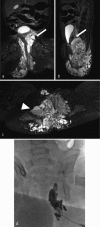Female Pelvic Vascular Malformations
- PMID: 29628618
- PMCID: PMC5886763
- DOI: 10.1055/s-0038-1636524
Female Pelvic Vascular Malformations
Abstract
Vascular malformations are classified primarily according to their flow characteristics, slow flow (lymphatic and venous) or fast flow (arteriovenous). They can occur anywhere in the body but have a unique presentation when affecting the female pelvis. With a detailed clinical history and the proper imaging studies, the correct diagnosis can be made and the best treatment can be initiated. Lymphatic and venous malformations are often treated with sclerotherapy while arteriovenous malformations usually require embolization. At times, surgical intervention of vascular malformations or medical management of lymphatic malformations has been implemented in a multidisciplinary approach to patient care. This review presents an overview of vascular malformations of the female pelvis, their clinical course, diagnostic studies, and treatment options.
Keywords: arteriovenous malformation; interventional radiology; lymphatic malformation; sclerotherapy; vascular malformation; venous malformation.
Figures



Similar articles
-
Pelvic vascular malformations.Semin Intervent Radiol. 2013 Dec;30(4):364-71. doi: 10.1055/s-0033-1359730. Semin Intervent Radiol. 2013. PMID: 24436563 Free PMC article. Review.
-
A Step-by-Step Practical Approach to Imaging Diagnosis and Interventional Radiologic Therapy in Vascular Malformations.Semin Intervent Radiol. 2010 Jun;27(2):209-31. doi: 10.1055/s-0030-1253521. Semin Intervent Radiol. 2010. PMID: 21629410 Free PMC article.
-
Vascular malformations involving the female pelvis.Semin Intervent Radiol. 2008 Dec;25(4):347-60. doi: 10.1055/s-0028-1102993. Semin Intervent Radiol. 2008. PMID: 21326576 Free PMC article.
-
Vascular Anomalies (Part II): Interventional Therapy of Peripheral Vascular Malformations.Rofo. 2018 Feb 7. doi: 10.1055/s-0044-101266. Online ahead of print. Rofo. 2018. PMID: 29415296 English.
-
Arteriovenous Malformations: Syndrome Identification and Vascular Management.Curr Treat Options Cardiovasc Med. 2018 Jul 18;20(8):67. doi: 10.1007/s11936-018-0662-7. Curr Treat Options Cardiovasc Med. 2018. PMID: 30019284 Review.
Cited by
-
Reliability of the application of transvaginal color Doppler ultrasound in the identification of pelvic tumors in women of childbearing age.Ann Transl Med. 2020 Dec;8(24):1662. doi: 10.21037/atm-20-7406. Ann Transl Med. 2020. PMID: 33490174 Free PMC article.
-
Pelvic arteriovenous malformation (AVM) with recurrent hematuria: A case report.Int J Surg Case Rep. 2023 Sep;110:108701. doi: 10.1016/j.ijscr.2023.108701. Epub 2023 Aug 22. Int J Surg Case Rep. 2023. PMID: 37633193 Free PMC article.
-
Treatment of iliac arteriovenous malformation associated with trisomy 21: a case report.J Cardiothorac Surg. 2024 Oct 7;19(1):594. doi: 10.1186/s13019-024-03062-6. J Cardiothorac Surg. 2024. PMID: 39375784 Free PMC article.
-
[A rare differential diagnosis of perianal abscess].Chirurg. 2019 Jul;90(7):585-587. doi: 10.1007/s00104-019-0971-8. Chirurg. 2019. PMID: 31073656 German. No abstract available.
References
-
- Mulliken J B, Glowacki J. Hemangiomas and vascular malformations in infants and children: a classification based on endothelial characteristics. Plast Reconstr Surg. 1982;69(03):412–422. - PubMed
-
- Wassef M, Blei F, Adams D et al.Vascular anomalies classification: recommendations from the International Society for the Study of Vascular Anomalies. Pediatrics. 2015;136(01):e203–e214. - PubMed
-
- Dasgupta R, Fishman S J. ISSVA classification. Semin Pediatr Surg. 2014;23(04):158–161. - PubMed
Publication types
LinkOut - more resources
Full Text Sources
Other Literature Sources

